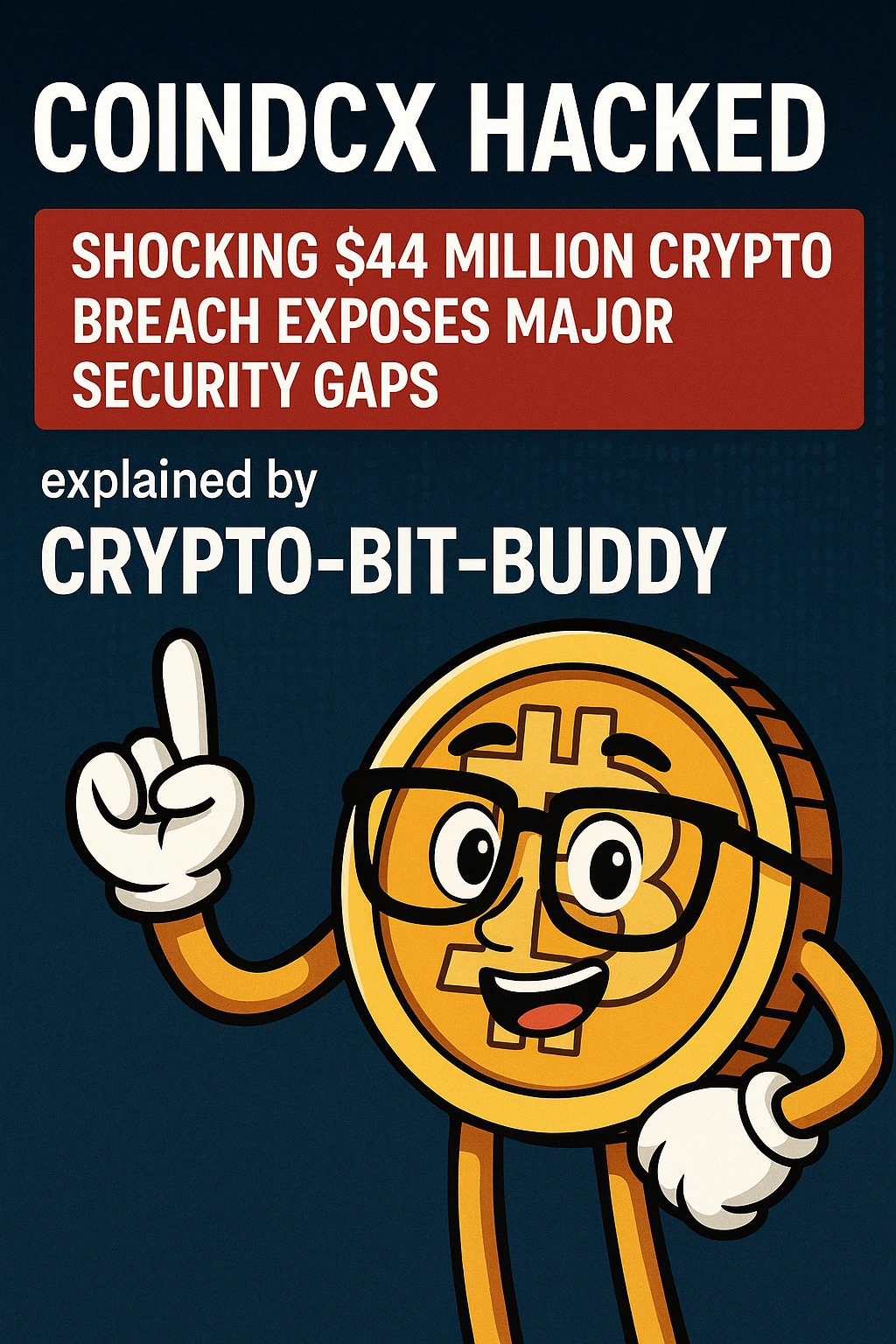CoinDCX Hacked: Shocking $44 Million Crypto Breach Exposes Major Security Gaps
.webp)
CoinDCX faces major security breach resulting in $44 million loss
Introduction to the CoinDCX Hack
On July 19th, 2024, India's leading cryptocurrency exchange CoinDCX fell victim to a devastating security breach that resulted in the theft of approximately $44 million worth of digital assets. This incident has sent shockwaves through the Indian crypto community and raised serious questions about exchange security protocols.
The hack represents one of the largest crypto thefts in India's history and highlights the critical importance of robust security measures in cryptocurrency exchanges. As the crypto industry continues to mature, incidents like these serve as stark reminders of the vulnerabilities that still exist in digital asset infrastructure.
Timeline of the Security Breach
Key Timeline Events:
- July 19, 2024 - 2:30 AM IST: Suspicious activity detected on operational accounts
- July 19, 2024 - 3:15 AM IST: Automated security systems triggered alerts
- July 19, 2024 - 4:00 AM IST: Trading and withdrawal services suspended
- July 19, 2024 - 6:30 AM IST: Internal investigation team assembled
- July 19, 2024 - 10:00 AM IST: Public announcement released
The breach was discovered through CoinDCX's monitoring systems, which detected unusual withdrawal patterns from operational wallets. The exchange's security team immediately implemented containment measures, including the suspension of all trading and withdrawal services to prevent further losses.
.webp)
Timeline of the CoinDCX security breach events
What Was Stolen in the Hack
The attackers successfully drained approximately $44 million worth of various cryptocurrencies from CoinDCX's operational wallets. The stolen assets included a diverse portfolio of digital currencies, with Bitcoin and Ethereum comprising the largest portions of the theft.
Breakdown of Stolen Assets:
- • Bitcoin (BTC): ~$18.5 million
- • Ethereum (ETH): ~$12.3 million
- • USDT: ~$8.7 million
- • Other altcoins: ~$4.5 million
According to blockchain analysis firm Chainalysis, the stolen funds were quickly moved through multiple wallet addresses in an attempt to obfuscate the trail. The sophisticated nature of the fund movement suggests the involvement of experienced cybercriminals.
Method of Attack
Initial investigations reveal that the attack was executed through a compromise of CoinDCX's internal operational accounts. The hackers exploited vulnerabilities in the exchange's partner network, gaining unauthorized access to hot wallets used for daily operations.
Attack Vector Details:
- • Compromise of internal operational accounts
- • Exploitation of partner exchange API vulnerabilities
- • Bypassing multi-signature wallet protections
- • Social engineering targeting key personnel
Security experts from Elliptic suggest that the attack bears similarities to previous exchange hacks, where insider knowledge or compromised credentials played a crucial role in bypassing security measures.

Analysis of the attack methodology used against CoinDCX
Impact on CoinDCX Operations
The immediate aftermath of the hack saw CoinDCX suspend all trading and withdrawal services as a precautionary measure. This decision, while necessary for security, significantly impacted user experience and trading volumes on the platform.
Customer communications were handled through multiple channels, including email notifications, social media updates, and a dedicated support portal. The exchange maintained transparency about the situation while working to restore normal operations.
Were User Funds Affected?
CoinDCX has categorically stated that user funds remain safe and were not directly affected by the security breach. The exchange maintains a clear segregation between operational funds and customer deposits, with user assets stored in separate cold storage wallets.
User Fund Protection:
- ✓ Customer deposits stored in segregated cold wallets
- ✓ Multi-signature security for user fund access
- ✓ Regular third-party security audits
- ✓ Insurance coverage for operational losses
The Role of Treasury Reserves in Absorbing the Loss
CoinDCX's treasury reserves played a crucial role in absorbing the $44 million loss without impacting user funds or platform solvency. The exchange had maintained substantial reserves specifically for such contingencies, demonstrating prudent risk management practices.
According to financial disclosures, CoinDCX maintains treasury reserves equivalent to approximately 15% of total user deposits, providing a significant buffer against operational losses and security incidents.

How treasury reserves protected user funds during the breach
Response from CoinDCX Leadership
CoinDCX CEO Sumit Gupta addressed the incident in a comprehensive public statement, acknowledging the severity of the breach while reassuring users about the safety of their funds. The leadership team demonstrated transparency by providing regular updates throughout the investigation process.
"We take full responsibility for this security incident and are committed to implementing even stronger measures to prevent such occurrences in the future. Our users' trust is paramount, and we will spare no effort in rebuilding it." - Sumit Gupta, CEO, CoinDCX
Industry and Community Reactions
The crypto community's reaction to the CoinDCX hack was mixed, with some praising the exchange's transparent communication while others expressed concerns about the overall security of Indian crypto platforms. Industry experts emphasized the need for enhanced security protocols across all exchanges.
Speculation about potential insider involvement has circulated within the community, though CoinDCX has denied any evidence of internal compromise. The incident has sparked broader discussions about employee vetting and access controls in crypto exchanges.
How This Hack Compares to Other Major Crypto Breaches
The CoinDCX hack bears striking similarities to the recent WazirX breach, which also involved the compromise of operational accounts and resulted in significant losses. Both incidents highlight systemic vulnerabilities in Indian crypto exchange security infrastructure.
2024 Crypto Theft Statistics:
- • Total crypto theft in 2024: $1.2 billion
- • Number of major exchange hacks: 12
- • Average loss per incident: $67 million
- • Recovery rate: 23%
According to Chainalysis, the CoinDCX hack represents approximately 3.7% of total crypto theft in 2024, making it one of the more significant incidents of the year.

Comparison of major crypto hacks in 2024
Security Measures Implemented Post-Hack
In response to the security breach, CoinDCX has implemented a comprehensive set of enhanced security measures designed to prevent similar incidents in the future. These measures include both technological upgrades and procedural improvements.
New Security Measures:
- • Launch of $1 million bug bounty program
- • Implementation of zero-trust security architecture
- • Enhanced multi-factor authentication for all staff
- • Real-time blockchain monitoring systems
- • Quarterly third-party security audits
Lessons for Other Crypto Platforms
The CoinDCX incident serves as a valuable learning opportunity for other cryptocurrency exchanges worldwide. Key lessons include the importance of maintaining robust internal security hygiene and implementing comprehensive risk management frameworks.
Industry experts recommend that exchanges regularly review and update their security protocols, conduct penetration testing, and maintain adequate insurance coverage to protect against operational risks.
Legal and Regulatory Implications
The hack has prompted discussions about the need for stronger regulatory oversight of cryptocurrency exchanges in India. Current cybersecurity laws require exchanges to report security incidents within 72 hours and implement specific protective measures.
Global compliance protocols, as outlined by organizations like the Financial Action Task Force (FATF), are becoming increasingly important for exchanges operating across multiple jurisdictions.
Tips for Users: How to Protect Your Crypto Assets
While exchange security is crucial, users must also take personal responsibility for protecting their crypto assets. Here are essential security practices every crypto investor should follow:
User Security Best Practices:
- • Choose exchanges with strong security track records
- • Enable two-factor authentication (2FA) on all accounts
- • Use hardware wallets for long-term storage
- • Never share private keys or seed phrases
- • Regularly monitor account activity
- • Keep only trading amounts on exchanges
For additional security guidance, users can refer to resources provided by Coinbase Learn and other educational platforms.
.webp)
Essential security practices for crypto investors
Future of CoinDCX Post-Breach
CoinDCX has outlined a comprehensive roadmap for recovery that focuses on rebuilding user trust and implementing industry-leading security measures. The exchange plans to invest significantly in cybersecurity infrastructure over the coming months.
User retention efforts include enhanced customer support, improved security features, and competitive trading incentives. The exchange is also exploring partnerships with leading cybersecurity firms to strengthen its defensive capabilities.
Conclusion
The CoinDCX hack serves as a sobering reminder of the ongoing security challenges facing the cryptocurrency industry. While the exchange's response has been largely positive, the incident highlights the need for continuous vigilance and improvement in security practices.
As we move forward in 2025, the crypto industry must prioritize security above all else. Only through collective effort, regulatory cooperation, and technological advancement can we build a safer ecosystem for all participants.
For the latest updates on cryptocurrency security and market developments, continue following Cointelegraph and other reputable crypto news sources.
Frequently Asked Questions (FAQs)
What caused the CoinDCX hack?
The hack was caused by a compromise of internal operational accounts, exploiting vulnerabilities in partner exchange systems and bypassing multi-signature wallet protections.
Is CoinDCX safe to use now?
CoinDCX has implemented comprehensive security upgrades including enhanced monitoring, bug bounty programs, and third-party audits. However, users should always practice personal security measures.
Will users get compensated?
User funds were not directly affected as they are stored separately from operational funds. The loss was absorbed by CoinDCX's treasury reserves.
What coins were affected?
The stolen assets included Bitcoin (~$18.5M), Ethereum (~$12.3M), USDT (~$8.7M), and various altcoins (~$4.5M) from operational wallets.
Was it an inside job?
While there has been speculation about insider involvement, CoinDCX has denied any evidence of internal compromise. The investigation is ongoing.
How can I secure my crypto assets?
Use hardware wallets for storage, enable 2FA, choose reputable exchanges, never share private keys, and keep only trading amounts on exchanges. Regular monitoring is also essential.